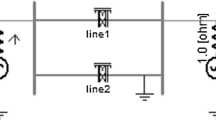Abstract
Inductive power transfer (IPT) systems facilitate contactless power transfer between two sides and across an air-gap, through weak magnetic coupling. However, IPT systems constitute a high order resonant circuit and, as such, are difficult to design and control. Aiming at the control problems for bidirectional IPT system, a neural networks based proportional-integral-derivative (PID) control strategy is proposed in this paper. In the proposed neural PID method, the PID gains, \(K_{P}\), \(K_{I}\) and \(K_{D}\) are treated as Gaussian potential function networks (GPFN) weights and they are adjusted using online learning algorithm. In this manner, the neural PID controller has more flexibility and capability than conventional PID controller with fixed gains. The convergence of the GPFN weights learning is guaranteed using Lyapunov method. Simulations are used to test the effective performance of the proposed controller.







Similar content being viewed by others
Explore related subjects
Discover the latest articles, news and stories from top researchers in related subjects.References
Wang C, Steilau O, Covic G (2005) Design considerations for a contactless electric vehicle battery charger. IEEE Trans Ind Electron 52(5):1308–1314
Madawala U, Thrimawithana D, Kularatna N (2007) An ICPT-supercapacitor based hybrid system for surge free power transfer. IEEE Trans Ind Electron 54(6):3287–3297
Swain A, Neath M, Madawala U, Thrimawithana D (2011) A dynamic model for bidirectional inductive power transfer systems. In: IECON 2011—37th annual conference on IEEE industrial electronics society, pp 1024–1029
Madawala U, Thrimawithana D (2011) A bidirectional inductive power interface for electric vehicles in V2G systems. IEEE Trans Ind Electron 58(10):4789–4796
Swain A, Neath M, Madawala U, Thrimawithana D (2012) A dynamic multivariable state-space model for bidirectional inductive power transfer systems. IEEE Trans Power Electron 27(11):4772–4780
Madawala U, Neath M, Thrimawithana D (2013) A power-frequency controller for bidirectional inductive power transfer systems. IEEE Trans Ind Electron 60(1):310–316
Neath M, Swain A, Madawala U, Thrimawithana D (2014) An optimal PID controller for a bidirectional inductive power transfer system using multiobjective genetic algorithm. IEEE Trans Power Electron 29(3):1523–1531
Chiou J, Tsai S, Liu M (2012) A PSO-based adaptive fuzzy PID-controllers. Simul Model Pract Theory 26(1):49–59
Chiou J, Liu M (2009) Numerical simulation for fuzzy-PID controllers and helping EP reproduction with PSO hybrid algorithm. Simul Model Pract Theory 17(10):1555–1565
Wang H, Yuan X, Wang Y, Yang Y (2013) Harmony search algorithm-based fuzzy-PID controller for electronic throttle valve. Neural Comput Appl 22(2):329–336
Cong S, Liang Y (2009) PID-like neural network nonlinear adaptive control for uncertain multivariable motion control systems. IEEE Trans Ind Electron 56(10):3872–3879
Yuan X, Wang Y (2009) Neural networks based self-learning PID control of electronic throttle. Nonlinear Dyn 55(4):385–393
Yu W, Rosen J (2013) Neural PID control of robot manipulators with application to an upper limb exoskeleton. IEEE Trans Cybern 43(2):673–684
Yuan X, Xiang Y, Wang Y, Yan X (2014) Parameter identification of bidirectional IPT system using chaotic asexual reproduction optimization. Nonlinear Dyn 78(3):2113–2127
Li Y, Ang K, Chong C (2006) PID control system analysis and design—problems, remedies, and future directions. IEEE Control Syst Mag 26(1):32–41
Aladag C, Egrioglu E, Yolcu U (2010) Forecast combination by using artificial neural networks. Neural Proc Lett 32(3):269–276
Acknowledgments
This work was supported in part by the National Natural Science Foundation of China (No.61104088) and Hunan Provincial Natural Science Foundation of China (No.2015JJ3053)
Author information
Authors and Affiliations
Corresponding author
Rights and permissions
About this article
Cite this article
Yuan, X., Xiang, Y., Wang, Y. et al. Neural Networks Based PID Control of Bidirectional Inductive Power Transfer System. Neural Process Lett 43, 837–847 (2016). https://doi.org/10.1007/s11063-015-9453-2
Published:
Issue Date:
DOI: https://doi.org/10.1007/s11063-015-9453-2




